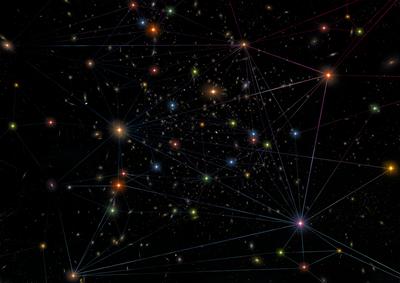New link found between mass of Supermassive black holes and their host galaxies

A team of astronomers has discovered a novel way to “weigh” supermassive black holes at the centres of galaxies by measuring the distances between the galaxies that contain them.
Mysterious, massive dark objects lurk at the centre of nearly all galaxies and can be observed with high enough sensitivity. Astronomers believe these to be black holes with masses that can exceed a billion Suns. Such supermassive black holes may power quasars, the most luminous sources in the Universe, and may halt the formation of stars by releasing copious amounts of energy which heats up and fragments the gas in their host galaxies.
One of their most astonishing properties is that, despite being tiny compared to their host galaxies - like a grape compared to the entire Earth - most observations suggest that the bigger the galaxy, the bigger the supermassive black hole it hosts. One does not expect the size of a grape to know about the size of the planet on which it grows!
This suggests there must be an intimate link between supermassive black growth and galaxy evolution, but this has not yet been proven. In this new study, published in Nature Astronomy, the international team led by Dr Francesco Shankar of the University of Southampton, in close collaboration with Dr Viola Allevato at the Normale di Pisa and other partners in USA, Germany, Italy, and Chile, set out to explain this link.
Accurately measuring the masses of supermassive black holes is usually achieved by measuring the velocity of the surrounding stars or gas. This is incredibly challenging and requires extremely sensitive telescopes and complex observations. However, galaxies and their supermassive black holes are believed to reside in haloes made of dark matter. Numerical simulations show that more massive dark matter haloes deviate more from a random spatial distribution – more strongly clustered. Therefore, their clustering strength can be used to weigh the halos.
Astronomers expect more massive black holes to be hosted by more massive halos, so the clustering of the black holes can be used to estimate the masses of their hosts. In turn, we can use this to constrain the masses of the black holes themselves. By comparing simulations with recent data on the spatial distribution of galaxies, the group found evidence that supermassive black holes are, on average, not as massive as previously thought.
Dr Shankar said: “These findings have significant implications for our understanding of the evolution and growth of supermassive black holes. What we have discovered suggests a greater ability to release energy, and less strength in powering gravitational waves as supermassive black holes merge.”